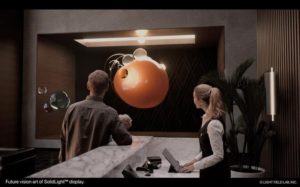“Believe it or not the building blocks for holographic TV are emerging,” says Adrian Pennington in his article, “The Holodeck Emerges Into the Light,” published this month in IBC365. “Among them is a standard format for creating, processing and transmitting content which is being supported by IDEA (Immersive Digital Experiences Alliance),” a group including Light Field Labs, and other holographic developers such as Otoy and Looking Glass Factory, along with the cable network Charter and cable industry think tank CableLabs. Good summary of the work of IDEA and digs into Light Field Labs new SolidLight panels and the technology behind them.

Holographic TV is one thing, but there are some who are already working on 3D two-way calling. In “Meta filed a patent for ‘3D conversations’ — are holographic calls almost here?” (from thenextweb.com), the author asks, what does it mean that “Meta, then Facebook, filed a Patent Application in 2020 titled 3D Conversations in an Artificial Reality Environment. Specifically, the application outlines a pipeline for capturing and transmitting 3D representations of callers, ‘allowing conversation participants to appear as if face-to-face.’”
“Meta’s patent suggests it is interested in using realistic 3D depictions to communicate body language. But it’s that broadness that makes it interesting too. Right now, one of the biggest hurdles for Zuckerberg’s vision of the metaverse is the fragmentation between virtual and real spaces.”
Granted, Meta isn’t the only company working on 3D calls. Google has Starline, Cisco has Webex Hologram, and Microsoft has its Mesh platform ….
Speaking of Webex, read “When your colleague is in the same room … but isn’t” (in Webex Ahead) for details on Webex Hologram, a platform that uses augmented-reality headsets to enable a feeling of true copresence by delivering realistic, 3D, real-time holograms of actual people.
Much of the discussion about 3D vs. 2D visual communications is about the advantage 3D gives in enhancing the ability to read facial expressions. And on that note, The Korea Advance Institute of Science and Technology (KAIST) reports on the development of a technique for facial expression detection by merging near-infrared light-field camera techniques with artificial intelligence (AI) technology. You can find a technical deep dive into that technique here —AI light-field camera reads 3D facial expressions (in ScienceDaily) —
In which Professor Ki-Hun Jeong, one of the leaders of the research team pursuing it says, “It could be applied in various fields including mobile healthcare, field diagnosis, social cognition, and human-machine interactions.”
In the world of large seamless 3D displays, SciTechDaily reports that researchers for University of Cambridge and Disney Research have “developed a new method to display highly realistic holographic images using ‘holobricks’ that can be stacked together to generate large-scale holograms.”
And finally on the topic of 3D meetings for everyone, Matsuko has an app for your iPhone that claims to make remote video meetings feel more like IRL conversations by using 3D holograms. Sound too good to be true? Read Fastcompany’s article here, “This startup wants to replace your Zoom meetings with holograms.
Posted March 29, 2022

